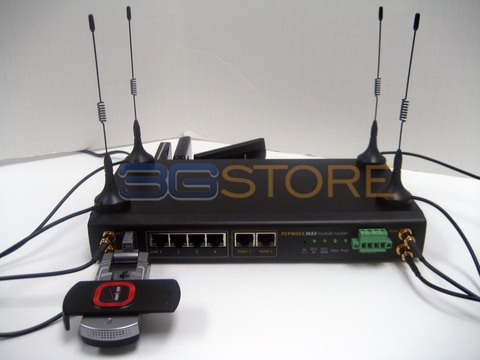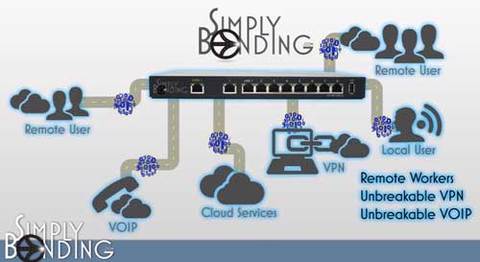Peplink Bonding / Link Balance 101605
Pages:
1

|
LiquidLayer private msg quote post Address this user | |
| Pepwave Max Bonding Information Source  Now that 4G wireless is becoming more widely available, the doors have been opened on what's possible over a mobile broadband connection. Over the past few years there has been an increasing demand for a "bonding" solution, which is different than traditional load balancing. So, one of the first question is what exactly is the difference between load balancing and physically bonding a connection? Load balancing allows you to take multiple modems and balance the load between them within the router directly. This load balancing method WILL NOT give you a single stream resulting in one faster download and upload speed. This simply balances the load to offset usage when your office needs to support a lot of concurrent users, not to increase a single stream. Physically bonding allows you to take multiple connections and turn them into one single stream, which allows you to have an increased download and upload speed. This can be incredibly useful for companies that demand a single pipe that offers faster speeds to download or upload real time video, route large amounts of traffic and handle video conferencing. After the connection has been bonded you can use their outbound traffic management feature to optimize outbound traffic and prioritize your VPN traffic. All you need to do modem or cable bonding is a Pepwave Max 700, Pepwave Max HD2 , or Pepwave Max On-the-Go and a Peplink Balance 210 or higher to establish the bonded VPN back to the Pepwave Max bonding router. Peplink/Pepwave SpeedFusion Modem Bonding: So how does VPN Bonding work? There are two pieces* of hardware that you'll need to establish a bonded VPN link to deliver a single bonded data stream. The first is the Pepwave Max, which should be deployed at the location where you need the larger bonded data stream. You will then need the Peplink Balance 210 or higher, that would be located back at the main facility connected to a high speed Cable connection. The Balance 210 or above is used to reconstruct all the single streams from all of the individual connections on the Pepwave Max. After the information is reconstructed, it's sent via a bonded VPN connection back to the Pepwave Max to give the remote location more bandwidth to work with.  You can bond up to four 3G/4G wireless modems, two WAN (cable/DSL) connections and a WAW (WiFi as WAN) connection. For optimal results it is recommended that you use "like" connections, which means you don't want to bond a 3G modem and cable connection together. You technically can bond a 3G and cable connection together, however, there will be more overhead than using connection types that have similar latency. This is why it's recommended to setup specific priority groups based on connection types for an optimal bonding experience. *SimplyBonding from 3Gstore is now available. This hosted service will give you all the benefits of a bonded internet connection, without the need for this expensive and complex dual router setup. For more information head to the bottom of this article. What is bonding overhead? To understand overhead, let's take the example of bonding two 3G wireless modems. Two 3G modems would be considered "like" connections, as they each provide similar speed and latency, so we can expect the optimal overhead of 10% loss when we bond them (bonding "unlike" connections - like a 3G modem and a 4G modem - would result in more overhead and isn't recommended). Assuming our two 3G modems each provide 1Mbps download speeds individually, when bonded we can expect approximately 1.8Mbps (1Mbps + 1Mbps - 10% overhead = 1.8Mbps bonded speeds). If you continue to add even more "like" connections, you'll lose another 10% to overhead for each additional modem. Bonding four 3G modems together will result in combined speeds of about 60% the total bandwidth all 4 modems combined are capable of, because of the 40% overhead loss. Adding additional modems will allow you to enjoy faster download and upload speeds. The traffic can then be distributed across all the links and a variety of rules can be added to direct traffic, allowing you to take full advantage of your bonded connection. You have the flexibility to either add or remove connections allowing you to scale based on different deployment requirements. If you don't have a need for a huge amount of bandwidth, simply bond two connections together to save on costs. Then if you need additional bandwidth, simply add more cards to the setup by simply plugging them into the USB inputs. This solution won't be for everyone, but if you meet the requirements below then you'll be able to configure VPN bonding without paying any additional monthly fees. What are the requirements to be able to bond multiple connections together? Main location where Balance 210 or higher will require a connection with a single static IP or URL You need a Pepwave Max (location where additional bandwidth required) and a Peplink Balance 210 or higher (to establish the bonded VPN) High speed data connection at main office location to provide sufficient bandwidth back to the Pepwave Max If you meet these requirements you'll be able to successfully bond 3G/4G modems, Cable/DSL connections and neighboring WiFi connections. The setup isn't difficult and when you purchase your equipment from 3Gstore you get free technical support for 1 year if you need any help with your configurations. We stock virtually all Pepwave/Peplink products and ship same day up to 3PM CST, if you're in a rush to get things deployed into the field. So, before you know it, you can have this equipment in your hands so you can easily stream your HD video, transfer large files, provide seamless failover and continuity between all available internet connections. How do I determine which Peplink product to use at the main location? Peplink Balance 210 - Designed to support 1 to 50 users and offers two WAN connections Peplink Balance 310 - Designed to support 1 to 50 users and offers three WAN connections Peplink Balance 380 - Designed to support 50 to 500 users and offers three WAN connections Peplink Balance 580 - Designed to support 300 to 1000 users and offers five WAN connections Peplink Balance 710 - Designed to support 500 to 2000+ users and offers seven WAN connections Why is the Pepwave Max the ultimate solution for bandwidth intensive applications? The Pepwave Max routers are the only ones on the market that can physically bond multiple connections together without any monthly recurring fee's. This means the only costs will be the hardware and the monthly service from your ISP that you're already paying for. In fact, if you're using any leased lines you'll be able to configure specific priorities ensuring you utilize the cheapest connections, and only use more expensive connections when necessary to further save you money. The Pepwave Max also transmits Bonded VPN traffic using 256-bit AES security, which is a military grade protection to ensure your data is secure. For applications like mobile command centers, yachts, tour buses etc, the small form factor Max router can be installed and is tolerant to power fluctuations. When choosing the Max 700 or HD2, you also get a globally capable router that currently supports more than 70 different USB modems giving you flexibility no matter where your travels take you. If you demand the ultimate bandwidth and network control in your environment the Pepwave Max is the ultimate solution for you! *** So you need to have a HQ and Remote location BOTH with peplinks at both ends in order to use the PepLink Speed Fusion Bonding... Otherwise if it is only one Peplink it will act as a Link Load Balancer as noted in the 1st paragraph. There is one provider we found that provides a connection into there Data Center where you can use a single peplink with speed fusion ability, and truly bond the connections. There is a 250.00 per month charge but it can be done and sometimes it is a great solution if you are located in an area where there is DSL available and upload speeds are max 2 megs up for example - it may be worth spending the monthly cost ... here is the info on simply Bonding: SimplyBonding is a hosting service that allows you to bond multiple internet connections into one super fast, super reliable, unbreakable connection with minimal equipment. Unlike failover or load balancing, a bonded connection takes multiple internet connections and COMBINES them. If you have 3 internet connections that are bonded together and one goes down, your connected devices and apps will never know there was a failure - even apps that maintain persistent connections! You only need 1 router with SimplyBonding, where as noted above traditional bonding solutions require two expensive routers each with access to a high speed internet connection!  What equipment is required and how much does it cost? SimplyBonding requires a SpeedFusion-capable router, a one-time setup fee, and hosting service that can be billed monthly, quarterly, or yearly. Router: You must use a Peplink or Pepwave router that supports SpeedFusion (like the Balance One or Balance 210) and has the necessary ports/connections for the internet links you'll be bonding (e.g. WAN ports for cable/DSL, USB ports for 3G/4G modems, etc). We will help you select an appropriate router if you don't have one. Hosting charge: SimplyBonding costs $250 per month, or you can choose to pay quarterly or yearly and save up to $575. All new users can test the service for FREE for 14 days. Setup fee: There is a one-time non-refundable setup fee of $250 to get your SimplyBonding service provisioned and set up. SimplyBonding is a hosting service that allows you to bond multiple internet connections into one super fast*, super reliable, unbreakable connection with minimal equipment. Unlike failover or load balancing, a bonded connection takes multiple internet connections and COMBINES them. If you have 3 internet connections that are bonded together and one goes down, your connected devices and apps will never know there was a failure - even apps that maintain persistent connections! How it works: SimplyBonding uses Peplink/'s Speedfusion technology to bond multiple 3G, 4G, DSL, or cable connections into one fast/reliable/unbreakable connection. Utilizing Speedfusion typically requires a Peplink router on both ends of the connection - one at the location where you need the bonded connection, and another at another location with a high-speed internet connection to bond the connections and send the data back to the primary location via VPN. SimplyBonding eliminates the need for this dual-router setup. SimplyBonding requires just ONE router, which will be configured to connect to our hosted service - WE handle the bonding and VPN for you! Costs and Requirements: SimplyBonding requires a Speedfusion-capable router, a one-time setup fee, and hosting service that can be billed monthly, quarterly, or yearly. Router: You must use a Peplink or Pepwave router that supports Speedfusion and has the necessary ports/connections for the internet links you'll be bonding (e.g. WAN ports for cable/DSL, USB ports for USB modems, etc). The tool on this page will help you select an appropriate router if you don't already have one. Hosting charge: SimplyBonding costs $250 per month, or you can choose to pay quarterly or yearly and save up to $575. All new users can test the service for FREE for 14 days. New users will only pay the setup fee at checkout, and the first service fee will not be charged for 14 days. If you decide to cancel within those 14 days, the service fee will not be charged. Setup fee: There is a one-time non-refundable setup fee of $250 to get your SimplyBonding service provisioned and set up. To get started, use the tool below to select a compatible router or enter your existing router information. *NOTE: Many factors influence the real-world throughput you'll see from a bonded connection, including connection type, the latency and speeds of your connections, IPS reliability, and traffic type. Cellular users should note that bonded cellular connections suffer from "flow control" of TCP traffic at the carrier level, and 3Gstore cannot guarantee that bonding multiple cellular connections will result in faster speeds (however, the other benefits of SpeedFusion bonding remain, such as unbreakable VPN, session persistence, and 100% up-time as long as you have 1 healthy WAN). Order Simple Bonding for $250.00 per month here Purchase Peplink Link Load Balancers here Performance Business Class Web Hosting - Cost of Starbucks Liquid Layer Networks | Performance Cloud Web Hosting http://www.LiquidLayer.net |
||
| Post 1 • IP flag post | ||
Pages:
1
